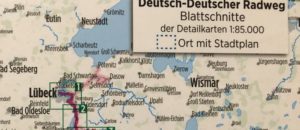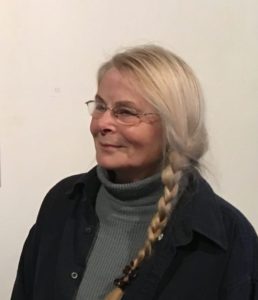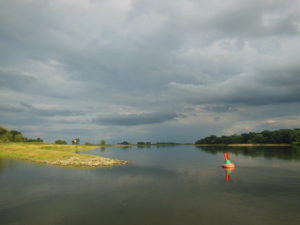 During my expedition along Germany’s death strip-turned-green-belt, I followed a strategy I came to think of as “structured sauntering.” The former border strip itself, with the help of a guidebook in my handlebar pouch and a GPS route in my phone, provided the geographical structure for my journey, from the Baltic coast in the north to the Czech border in the south. The spirit of my journey was infused with the words of Henry David Thoreau, who described the word “sauntering” as derived from
During my expedition along Germany’s death strip-turned-green-belt, I followed a strategy I came to think of as “structured sauntering.” The former border strip itself, with the help of a guidebook in my handlebar pouch and a GPS route in my phone, provided the geographical structure for my journey, from the Baltic coast in the north to the Czech border in the south. The spirit of my journey was infused with the words of Henry David Thoreau, who described the word “sauntering” as derived from
[…] idle people who roved about the country, in the Middle Ages, and asked charity, under pretense of going a la Sainte Terre, to the Holy Land, till the children exclaimed, “There goes a Sainte-Terrer,” a Saunterer, a Holy-Lander. They who never go to the Holy Land in their walks, as they pretend, are indeed mere idlers and vagabonds; but they who do go there are saunterers in the good sense, such as I mean. Some, however, would derive the word from sans terre, without land or a home, which, therefore, in the good sense, will mean, having no particular home, but equally at home everywhere. For this is the secret of successful sauntering. He who sits still in a house all the time may be the greatest vagrant of all; but the saunterer, in the good sense, is no more vagrant than the meandering river, which is all the while sedulously seeking the shortest course to the sea.[1]
While my journey was not literally aimed at the Holy Land, it was nevertheless directed toward something I consider in the realm of the sacred: the land itself and the stories it holds, of the rocks, the rivers, the soil, and the living beings in and on the land. In particular, I wanted to find out how a dividing line drawn across the land had shaped the people and the land around it. So in some way I would indeed be asking for charity: not for money or for food, but for people’s stories and memories.
There was also the element of home in the second interpretation Thoreau cites: “sans terre,” “without land or a home.” This is a central question in the lives of those who have left their original home, whether by choice, necessity, or force. Can one ever find another home? Or is it possible to be equally at home everywhere, as Thoreau suggests?

Among the people I met along my journey, one who stands out for her charity toward me – not only with memories and stories, but also with food and lodging – is Silke Kowalski, an artist who lived a stone’s throw from where the border fence once stood, denying her and her family access to the the river Elbe. Among many other things, I asked Silke what Heimat means to her. I post her reflections here in the spirit of Thanksgiving. Towards the end, she talks about her husband, who had died just a few months before I met her. As a young child, he was left “sans terre” (without a home or land) by war, an experience shared by far too many people then and now. He was fortunate to find and build a new Heimat with Silke.
Silke Kowalski on Heimat
Heimat, for me, begins with the view of the ridgeline of Hitzacker[a town on the other side of the Elbe]. While I have never been away for long from the surroundings of my childhood, seeing these blue hills when I return from a trip makes me happy.
I love the smell of the Elbe River and the resiny scent of the woods. The juicy green of the meadows in the Elbe floodplain gives me joy, and with it the cries of the grey and silver herons, the swans and wild geese, and the happy twitter of the swallows.

My birthplace is between the Elbe’s ancient glacial valley and the Rens, a pine forest that stretches over a large area. In August, tall grasses flower in the clearings; when there’s wind they undulate like a red sea. Now and then you come across dunes that formed during the last ice age. In places, reindeer lichens and dune grasses have taken hold on them. It feels wonderful to walk on them barefoot; they scratch your feet so pleasantly there’s a light rustle. In summer, the dunes warm up in the places the wind has swept clear. I have often sat in the warm sand letting the fine, white crystals that had been there for millions of years trickle through my fingers. This would give me a feeling of infinity on the one hand, and on the other a sense of the finiteness of our human existence.
But the thing I liked best about all of my explorations was the thought that my forebears had once walked the same paths, breathed in the same smells, were surrounded by the same bird life, and saw the ridges of those blue hills.
I searched for and found the traces of their existence. The trees they had planted, the gardens they had brought to life. The handles of rakes, hayforks, and hoes – they all were worn smooth from their hands’ work over many years. I reverently admired each door, each cupboard, each sewing kit if I had been told “your father built this.” My father, whom I had never seen, because the war took him away from me. And still I had a feeling that I was close to him. I grew up under the roof of the house that my parents had built together.
For all this, I am grateful.
My husband was less fortunate, for his father, too, had died in the Second World War. Wolfgang only knew his father from picture albums and from his mother’s stories. At the age of four, he had to leave his birthplace in Pomerania[2], together with his mother and grandmother.
For many years, the boy felt out of place in the town they settled in. At fifteen he began his professional training, in yet another town. At nineteen Wolfgang was ready to begin his professional life and found employment in the area of my Heimat. At that time he felt rootless; he called himself a “heimatloser Geselle” – a wanderer without a home, or place of belonging.
This only changed gradually over the years, as we built our own little world and saw our children grow up. Wolfgang had finally arrived at his home. My Heimat had become his. He planted trees, he built things and worked tirelessly. The traces of his hands’ work will still be there for coming generations to see and experience – as long as another senseless war does not destroy everything that is good and beautiful for so many people.
Silke Kowalski’s daughter Britta, who was equally generous to me, shared her reflections on Heimat in the previous post.
[1]Henry David Thoreau, 1862: Walking
[2]An area in what is now Poland, from which the ethnic German population either fled or was expelled after WWII when the German-Polish border was shifted west.

[…] Today’s post is in German, at the request of some German readers. If you missed this post in English, you can find it here. […]
[…] while ago, I wrote about how I came to see aspects of my border expedition as something like a pilgrimage. While my journey was not literally aimed at the Holy Land or a sacred site, it nevertheless […]